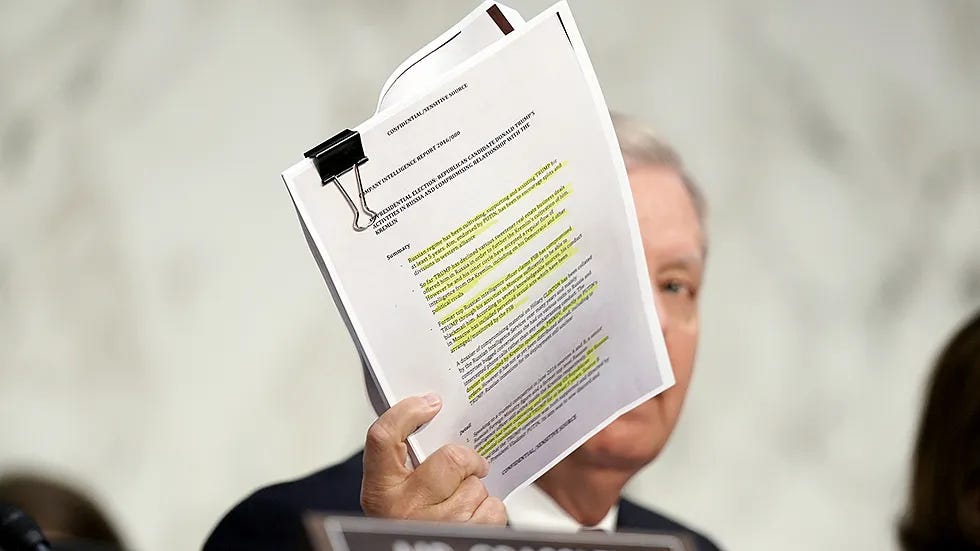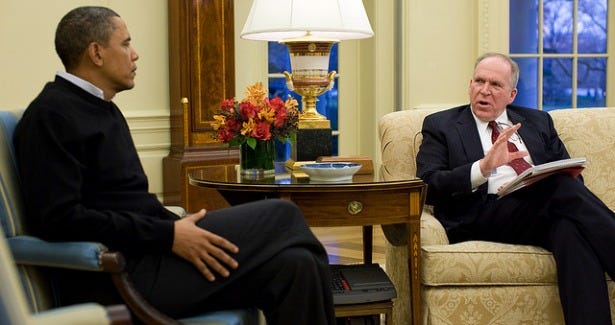Weaponized Intelligence: Inside the CIA’s Rushed and Politicized 2016 Assessment
A 2025 internal review reveals how Brennan, Clapper, and Comey bypassed standard tradecraft, excluded dissenting agencies, and used the 2016 Russia report to push a political narrative that never met
On June 26, 2025, the Central Intelligence Agency released a long-classified internal review of its role in one of the most consequential intelligence assessments in recent history, the 2016 Intelligence Community Assessment (ICA) on Russian election interference. The review doesn't deny that Russia interfered in the election. What it does expose is that the Intelligence Community Assessment’s (ICA) most politically explosive conclusion, that Vladimir Putin "aspired" to help Donald Trump win, was the product of a rushed process, limited sourcing, and unprecedented political interference. At the center of it all were three names:
John Brennan, then-Director of the CIA
James Clapper, then-Director of National Intelligence
James Comey, then-Director of the FBI
On December 6, 2016, just six weeks before he left office, President Obama ordered an expedited assessment on Russian election interference. That directive triggered a fast-tracked process that collapsed under its own weight. According to the CIA’s 2025 review, the ICA was drafted in under a week and coordinated in less than 48 hours. Analysts were given hard copies only days before a final review, which occurred on December 19. This was not a rigorous assessment built over months. It was a politically timed document, completed under artificial urgency. The review explicitly questions whether the White House’s timeline was driven by intelligence needs or political motives. The very first page of the note, conspicuously missing an updated classification block, reflects how hastily even this accountability document was assembled.
Brennan oversaw the ICA’s production and hand-selected the CIA analysts who drafted it. Clapper and Comey were active participants throughout. Their involvement wasn’t casual. It was deeply hands-on and, in the words of the review, "highly unusual in both scope and intensity." These three officials narrowed the process to just four agencies — CIA, ODNI, FBI, and NSA — excluding 13 others, including those with counterintelligence expertise. They shut out the National Intelligence Council and shaped the process in ways that stifled dissent. Analysts and managers who would typically review or challenge judgments were left on the sidelines, with some saying they were only read into key intelligence days before the final draft. One CIA officer described it as chaotic. Another said the level of top-down pressure was so intense that some analytic managers declined to participate in the review altogether.
While much of the ICA focused on broad Russian efforts to undermine trust in U.S. institutions, the specific claim that Putin wanted Trump to win carried the highest political weight and the weakest support. The review found that this judgment relied heavily on a single serialized CIA report that was ambiguous and unevenly distributed. Some readers within CIA said they didn’t even agree on what it meant. "We don’t know what was meant by that," one senior operations officer said. "Five people read it five ways." Despite that, Brennan’s team attached a high confidence label to the finding, ordinarily reserved for judgments backed by multiple, high-quality sources. NSA objected. Others pushed back. A compromise was reached to downgrade the judgment to moderate confidence, but by then, the political impact had already landed.
Even more damaging than the weak sourcing was what the ICA chose not to include. Analysts failed to explore competing interpretations of Russia’s actions, including the possibility that Putin simply wanted to sow chaos. Credible intelligence that suggested Putin might not have had a clear preference was left out. Reporting that undercut the "aspired" narrative never made it into the final product. In other words, the ICA didn’t tell the full story. It didn’t present alternative scenarios, didn’t disclose its own uncertainties, and didn’t explain why dissenting voices inside the community were ignored. It presented a conclusion and nothing else.
The most egregious act came when Brennan insisted on including the Steele Dossier in the ICA, despite widespread objections from the report’s own authors and from senior CIA officials with Russia expertise. Comey backed him. The Steele Dossier was unverified political opposition research, and the FBI had already offered Christopher Steele $1 million to substantiate it, with no results. Nevertheless, Brennan attached a two-page summary of the Dossier in the ICA annex and cited it directly beneath the "aspired" judgment. This maneuver didn’t just insert junk intelligence into a formal assessment. It elevated unproven material to the status of supporting evidence. The CIA review calls this a clear violation of analytic standards. The inclusion wasn’t an oversight. It was a deliberate choice made by men who had already chosen a narrative and were determined to reinforce it.
The 2025 review doesn’t shy away from naming those responsible. Brennan orchestrated the process from start to finish. Clapper and Comey helped drive the conclusions. All three took extraordinary steps to shape the ICA around a specific political story. Former DNI John Ratcliffe didn’t mince words when he told the New York Post, "This was Obama, Comey, Clapper, and Brennan deciding:
“We’re going to screw Trump."
Whether or not that rises to the level of criminal intent, the review makes one thing clear: this was a serious abuse of institutional power, executed by the most senior figures in the U.S. intelligence community.
In its final section, the CIA review lists the lessons that should have been obvious from the start. Don't rush assessments under political pressure. Don’t exclude half the intelligence community. Don’t assign high confidence to single-source judgments. Never allow unverified political documents to influence the findings. The CIA claims it has applied these lessons ahead of the 2024 election cycle, and it plans to use this review as part of its internal training at the Sherman Kent School for Training Analysis.
That may help prevent a repeat. But it doesn’t erase what happened.
The ICA’s most politically damaging claim, that Russia aimed to elect Donald Trump, was built on inference, ambiguity, selective sourcing, and political motive. It was a story promoted by Brennan, Clapper, and Comey under a rushed directive from Obama himself. They sidelined dissent, ignored objections, and elevated a single, unverified document to push a judgment that could not withstand scrutiny. They used the U.S. intelligence system not to inform, but to influence. The public deserves to understand how it happened.







